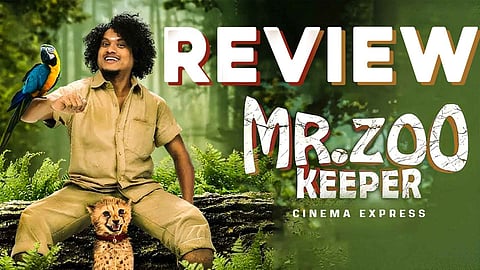Mr Zoo Keeper Movie Review: Real tiger, real issues, but unrealised potential
Mr Zoo Keeper(1 / 5)
Mr Zoo Keeper Movie Review:
When Pugazh is first introduced in Mr Zoo Keeper, the setting is a carrot factory nestled in a small village in the Nilgiris. As the factory owner speaks to him in a patronising tone, Pugazh channels his inner Vikram from Deiva Thirumagal, embodying the qualities of Chinna Thambi, a man described as “vevaram theriyadhavan,” who exhibits all the stereotypical traits often associated with intellectual disability. The film never clearly names or explores his condition, a convenient escape route for the makers, who repeatedly label him with vague terms like “naive,” “innocent,” and “different". Singampuli, whose character is also named the same in the film, even goes so far as to call him “half-boil,” a tasteless attempt at insult comedy. But what’s more troubling is the way the film treats his transformation. When danger befalls his wife, played by Shirine Kanchwala, Chinna Thambi musters the courage to protect her, and from that point on, he is suddenly portrayed as “normal.” With a single act of bravery and the sentimental claim that a tiger helped him “become okay,” the film suggests that disability can be shed like old fur through sheer will or emotional awakening. It’s a deeply flawed message at the heart of a film that otherwise seems eager to push a message it believes is urgent.
Cast: Pugazh, Shirine Kanchwala, Singampuli
Director: J Suresh
Chinna Thambi happens upon a tiger cub. But, mistaking it for a kitten, he brings it home as a pet. When the sudden disappearance of the cub puts pressure on the forest department, Chinna Thambi and his wife, eager to avoid legal entanglements, decide to return the little one to the wild. But when they realise that the forest itself may be no place for an innocent cub, the couple chooses to raise it themselves. Of course, that decision comes with its own share of unexpected troubles.
Mr Zoo Keeper’s unique selling point is the real tiger, promised as the film’s central attraction. Yet, during the first half, we rarely get a full view of the jungle cat. It’s only in the second half that glimpses of the striped feline appear, but even then, the shots are framed in a way that strains the eye. Close-ups are frequently zoomed in on the tiger, and when the camera pulls back, the transition lacks coherence, jarring the viewer. Though this may seem like a minor issue popping up occasionally, the film suffers more critically from narrative inconsistencies caused by flawed editing. For instance, in a scene, Chinna Thambi walks in the forest with the cub in his backpack. He slips and falls down, and the scene cuts to a different location with forest officials. When we get back to Chinna Thambi, they’ve moved on with no mention of his fall. Such disjointed editing disrupts the flow and weakens the storytelling.
If the film occasionally rises like a phoenix from its ashes, it is mainly during the forest sequences featuring Singampuli. Chinna Thambi and his wife attempt to return the cub to its natural habitat, guided by Singampuli, a local familiar with the region. These scenes take a dig at the commercial activities threatening the forest’s flora and fauna, attacking a Patanjali-like company and casting a wary eye on ecotourism. While the message is much needed and the intent is commendable, the execution drags these portions into monotony. Dialogues are repeated as if addressing a child, and the scenes play out at a tortoise's pace, sapping the impact of an otherwise important theme.
While these issues are noteworthy, the biggest elephant in the room is undoubtedly the cast’s performances. Pugazh comes across as repetitive in his attempt to stand out by playing a disabled character, and when he tries to show “bravery,” it only worsens. Shirine feels like a fish out of water; she neither fits into the setting nor delivers her lines convincingly. The performances of the supporting cast, particularly the forest officials, further weaken the film’s impact.
The idea behind the film is efficient: to promote environmental conservation and to highlight that animals are often more trustworthy and innocent than humans. Unfortunately, the film’s execution falls short of achieving this goal. It could have easily ended about 30 minutes earlier, but instead, it stretches on, showing an adult tiger, its role in saving a village, a court case, and much more. Towards the end, even the legal system feels lightly mocked. When the film finally concludes and the credits roll, you’re left reflecting on how the experience might have been more engaging in a different setting—perhaps a quiet afternoon at the zoo.


